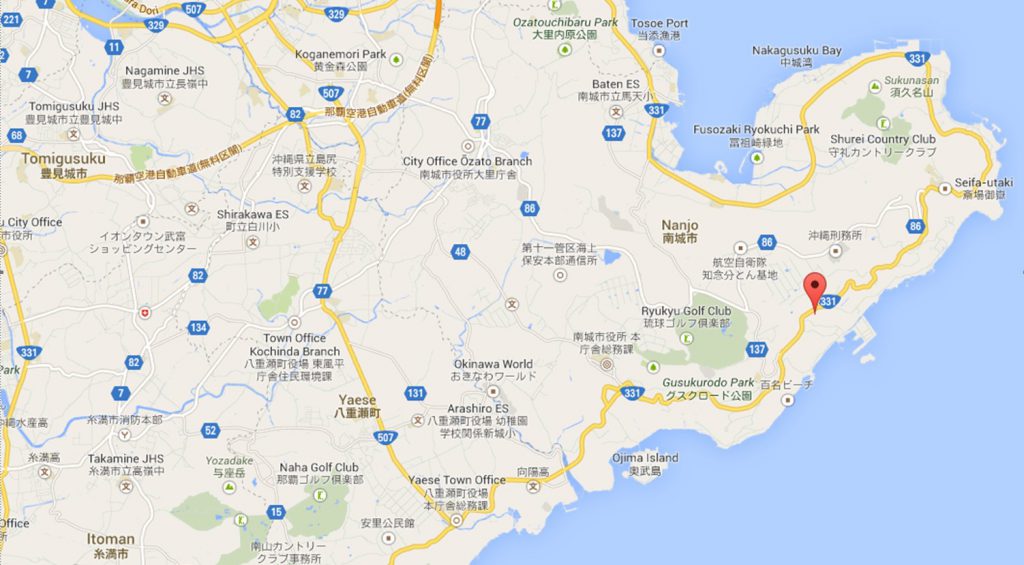Chinen Shikiyanaka is remembered as a master of bōjutsu. It is said that he begun to study bōjutsu while serving as a live-in public apprentice of the Soeishi Udun, a clan related to the royal family. It is said that he was blessed with a natural gift and developed his own distinctive skills. According to tradition, he entered the mountains at night and practiced the techniques against standing trees. “Chinen Shikiyanaka no Kon” is said to be his creation and the culmination of his studies. In martial arts bōjutsu (kobudō), Chinen Shikiyanaka no Kon has been handed down by Taira Shinken as well as by Nakazato Jōen.
In Taira Shinken lineage, characteristic techniques include a lower-level sweep (gedan-barai) performed in one-leg-stance (ippon-dachi), the original application of which is sunakake (hurling sand or gravel etc.). It also has a “inside pulling sweep” (uchi-hiki-uke) followed by a “return strike” (kaeshi-uchi), as well as a “reversed sweep” using the left end of the bō. Three different grips are used, including the “long grip” at the end of the bō for swinging it as well as a long-range, spear-like thrust. The longest combination, done left and right, comprises of fourteen consecutive techniques.
The above is about the bōjutsu kata of kobudō. Kobudō people usually differentiate between village bojūtsu (mura-bō) and martial arts bōjutsu (kobudō). However, it seems there have been a back-and-forth influence between the two over a long time. Arguably, martial arts bōjutsu (kobudō) might have received an upswing only since the early 20th century and received a lot of help and inspiration from village bojūtsu (mura-bō).
“Shikiyanaka” is a yagō, that is a name to identify individuals otherwise difficult to identify. It is not an official name and most probably Shikiyanaka was a commoner. During the Ryukyu kingdom era, commoners would not have a last name nor an official genealogy. Only after the establishment of Okinawa prefecture, everyone would receive a last name and that is probably why they are all similar without their genealogy actually going back to a lineage holder of the kingdom times.

Shikiyanaka was probably one of those rural officials who would receive some amount of education on-site in Shuri from the family of the owner of the territory, such as the Soeishi Udun. Back home he would perform administrative work for their feudal lords.
Not only local events and local businesses, but also ceremonial occasions such as weddings and funerals are still held at the village level. In this way, this bōjutsu of Shichiyanaka became a performing tradition of his home region of Chinen. It is still handed down in Okinawa under the name of “Shikiyanaka nu Bō” in the former Shikiya part of Chinen village and performed as part of the event called Yōkabī ヨーカビー (= events performed from August 8 to 11 of the old lunar calendar). These days are considered unlucky days, so a variety of events are performed to drive out misfortune. Typically, firecrackers (hyōchaku ヒョーチャク) are vigorously released and lively feasts are held.
As weapons, rokushaku-bō (six-foot staffs) are used, which are otherwise stored by tying it to the alcove post of the houses of the owners – in martial arts bōjutsu (kobudō) on the other hand, it is usually stored in the dōjō.
“Shikiyanaka nu Bō” features two-person cudgel practice, four-person cudgel practice, bō vs bō and it also features Danna-bō. As regards the latter, following the abolition of the feudal fief (1875/79), police constables, government officials and the like were referred to a Danna. Because of the above, while it is a village fencing (mura-bō), it should be considered a martial art, albeit not presented as a Japanese budō, as in case of kobudō.
Within the village communities, Shikiyanaka nu Bō has been traditionally handed down from the elders to the young people. During the era of districts under the royal government, Chinen had fourteen villages, including Shikiya and Ue-Shikiya. In 1908 Shikiya became one of seven sections of Chinen village. In January 2006, Chinen, along with the town of Sashiki, and the villages of Ōzato and Tamagusuku (all of Shimajiri District), were merged to create the city of Nanjō. Shikiyanaka nu Bō has been designated a cultural property by the Chinen Village Board of Education.
Sources:
- Hokama Tetsuhiro: Okinawa Karate Kobudô no Shinzui (1999)
- Okinawa Karate Kobudō Jiten (2008)
- Shuri Naha Dialect Dictionary
- Karate-dô, Kobudô Kihon Chôsa Hôkokusho (1994).
- Taira Shinken: Ryūkyū Kobudō Taikan (1964)
- Andreas Quast: research material
© 2020, Andreas Quast. All rights reserved.
